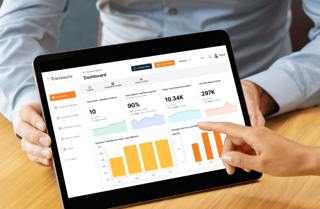1 Centralise data
Data from a range of sources, such as maintenance providers, fuel card providers, insurance companies, HR systems, accident management providers and vehicle procurement sources, should feed into a fleet software system allowing fleet operators to have all the details in one place.
“The most significant benefits have been in terms of giving me instant access to a wide range of fleet data instead of taking ages to hunt around spreadsheets for the information,” says Tyrone Lanaway, fleet manager at AK Worthington, who uses Jaama’s system.
2 Bring departmental efficiencies
Having all the data in one place and making it accessible across departments avoids duplications of processes and data entry.
It can also reduce the phone calls the fleet department receives from other branches or departments, as Travis Perkins found out when it installed Tranman.
It estimates that the Tranman vehicle information web portal has reduced phone traffic into the transport department by 60% with branches able to find the information they need themselves.
3 Manage fuel costs
The rising price of fuel is one of the biggest concerns for fleet operators this year and software providers claim they can help fleets take control of fuel costs.
Neville Briggs, managing director of CFC, says: “Every day we talk to fleet managers who see fuel as a cost that cannot be controlled, yet our experience is actually that it is one of the fleet costs that responds better to tighter management."
"Reducing overall fuel spend is very much possible.”
Jaama agrees. Its customers have reported fuel spend reductions of up to 8% after implementing its software.
Fleet software (in conjunction with fuel card data) allows fleet operators to identify when super premium fuels are being purchased instead of regular fuels and compare actual mpg against expected mpg or to be alerted when a vehicle exceeds a target mpg figure.
Ashley Sowerby, managing director of Chevin Fleet Solutions, says: “By identifying specific individuals, fleet managers have the evidence and information needed to influence future habits at the petrol pump.”
Marie Jarrold, fleet manager at BCA, reminds drivers to buy fuel at supermarkets and monitors usage via Jaama’s system.
Software also allows companies to detect fuel card fraud.
Jaama’s system, for instance, uses data imported from CAP to highlight model fuel tank capacity.
It ensures that the purchase of fuel quantities greater than vehicle fuel tank capacity can be easily identified.
4 Manage the grey fleet
Data associated with drivers using their own vehicles for business trips can be managed using fleet software, helping
companies to meet their duty-of-care obligations.
This includes storing insurance documents (showing that the vehicle is insured for business use), vehicle maintenance records and MOT certificates. Reminders can be set up to prompt action when these documents are due for renewal.
5 Check driving licences
Driver licence checking has been the major growth area in fleet software over the last couple of years, according to CFC.
Some software companies, such as Jaama, offer this as a standalone product or as part of the software package.
Tranman, meanwhile, integrates with third-party drive licence checking services.
Jaama’s checking service can handle all the admin associated with licence checking, including obtaining a signed three-year mandate giving permission for the checks to be carried out and issuing reminders, obtaining information from the DVLA, alerting fleet operators to any licence issues that the check has found and uploading the information.
Alerts can be set up for licence renewals, such as when the photocard licence expires after 10 years.
6 Manage workshops and control stock
For companies with in-house maintenance, software allows them to move to a more efficient way of working. Strathclyde Police, which services and maintains its fleet of 2,000 vehicles and plant in four workshops across Strathclyde, used Tranman to switch from job cards to technicians entering data using touchscreens.
They benefit from real-time management information and faster job turnaround.
Tranman software can also put restrictions in place to ensure the workshop is never overloaded.
Software also allows stock levels to be managed and to minimise downtime from unavailability of essential spare parts.























Login to comment
Comments
No comments have been made yet.